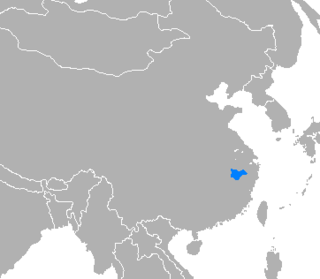
Back Chinu hui AST Sinaeg Huizhou Breton Hui (llengua) Catalan Hui (Sprache) German Chino hui Spanish چینی هوی Persian Hui (langue) French Huizhouish GV Huizhou kineski (jezik) Croatian 徽語 Japanese
| Huizhou | |
|---|---|
| 徽州話 / 徽州话 | |
| Native to | China |
| Region | Huizhou, southern Anhui, neighbouring portions of Zhejiang and Jiangxi |
Native speakers | 5.4 million (2021)[1] |
| Language codes | |
| ISO 639-3 | czh |
| Glottolog | huiz1242 |
| Linguasphere | 79-AAA-da |
 | |
| Huizhou Chinese | |||||||||||||||||||||||||||
|---|---|---|---|---|---|---|---|---|---|---|---|---|---|---|---|---|---|---|---|---|---|---|---|---|---|---|---|
| Simplified Chinese | 徽州话 | ||||||||||||||||||||||||||
| Traditional Chinese | 徽州話 | ||||||||||||||||||||||||||
| Hanyu Pinyin | Huīzhōuhuà | ||||||||||||||||||||||||||
| |||||||||||||||||||||||||||
| Alternative Chinese name | |||||||||||||||||||||||||||
| Simplified Chinese | 徽语 | ||||||||||||||||||||||||||
| Traditional Chinese | 徽語 | ||||||||||||||||||||||||||
| Hanyu Pinyin | Huīyǔ | ||||||||||||||||||||||||||
| |||||||||||||||||||||||||||
Huizhou Chinese (Chinese: 徽州话), or the Hui dialect (Chinese: 徽语), is a group of closely related Sinitic languages spoken over a small area in and around the historical region of Huizhou (for which it is named), in about ten or so mountainous counties in southern Anhui, plus a few more in neighbouring Zhejiang and Jiangxi.
Although the Hui area is small compared with other Chinese dialect groups, it displays a very high degree of internal variation. Nearly every county has its own distinct dialect unintelligible to a speaker from a few counties away. For this reason, bilingualism and multilingualism are common among speakers of Hui. It is estimated that there are around 4.6 million speakers of Huizhou varieties.[citation needed]
- ^ Huizhou at Ethnologue (26th ed., 2023)

© MMXXIII Rich X Search. We shall prevail. All rights reserved. Rich X Search